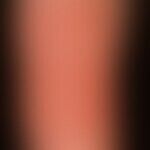Synonym(s)
DefinitionThis section has been translated automatically.
Rare form (about 40 cases described in the literature) of a physical urticaria caused by heat exposure.
ClassificationThis section has been translated automatically.
A distinction is made between:
Heat contact urticaria (immediate type, triggered by direct exposure to heat)
heat reflex urticaria (remote reaction, see also reheating urticaria)
Heat urticaria, familial type (only a few cases have been described - Michaëlsson G et al. 1971).
You might also be interested in
EtiopathogenesisThis section has been translated automatically.
ClinicThis section has been translated automatically.
After passive heating of the skin or mucous membranes (typical are hot baths, hot blow-dryers or hot drinks; temperatures generally > 38 °C), rapidly itchy urticarial lesions appear at the contact points. Symptoms persist only briefly.
DiagnosisThis section has been translated automatically.
General therapyThis section has been translated automatically.
Avoidance of heat, effort, emotional stress and sweating (transitions to cholinergic urticaria). In acute attacks, treatment like acute urticaria. S.a. physical urticaria.
Tolerance induction by warm baths has been described as successful.
External therapyThis section has been translated automatically.
Blande, itch-killing local therapy e.g. with Lotio zinci, Lotio Cordes, zinc oxide emulsion LAW. If necessary, lotions/compounds/creams with addition of 2-5% polidocanol (e.g. polidocanol cream 2-5%, R200 ) or 1% menthol (e.g. menthol cream 1% or 1% menthol solution).
Alternative: Short-term application of topical glucocorticoids as emulsion (e.g. Triamgalen Lotion, R123 ) or as cream (e.g. Triamgalen Cream, R121 ).
Alternatively, a test with ointment containing capsaicin(e.g. dolenone, capsamol).
Internal therapyThis section has been translated automatically.
Antihistamines mostly effective: Levocetirizine (e.g. Xusal) 1 tbl/day, Desloratadine (e.g. Aerius) 1 tbl/day, also Fexofenadine hydrochloride (e.g. Telfast) or Mizolastine (e.g. Zolim). Sedative antihistamines: Clemastine (e.g. Tavegil) 2 times/day 1 tbl/day or Dimetinden (e.g. Fenistil) 2 times/day 1 tbl/day, Hydroxycin (e.g. Atarax) 1-3 tbl/day.
Alternatively: Indometacin (e.g. Indomet-ratiopharm) 50-150 mg/day, Opipramol (e.g. Insidon) 50-100 mg/day p.o. or on a trial basis DADPS 50 mg/day. Cave! Determination of glucose-6-phosphate dehydrogenase before starting therapy.
There are single positive reports about omalizumab (Pezzolo E et al. 2016).
Progression/forecastThis section has been translated automatically.
Chronic course (>2 years) is likely.
LiteratureThis section has been translated automatically.
- Czarnetzki BM et al (1991) Urticaria, diagnostics and therapy. Dt Derm 39: 280-286
- Constantinos P et al (2003) Multiple physical urticarias: report of three cases and review of the literature. Allergy Asthma Proc 24: 313-317
- Butcher M, grave J (2004) Physical urticaria. dermatologist 55: 344-349
- Giménez-Arnau A (2015) Contact urticaria and the environment. Rev Environ Health. 29:207-215
- Illig L et al (1969) Clinic and Diagnosis of Physical Urticaria Dermatologist 20: 167-178
- Kennard CD et al (1991) Pharmacologic therapy for urticaria. J Am Acad Dermatol 25: 175-187
- Michaëlsson G et al (1971) Familial localized heat urticaria of delayed type. Acta Derm Venereol 51:279-283.
- Pezzolo E et al. (2016) Heat urticaria: a revision of published cases with an update on classification
- and management. Br J Dermatol 175:473-478.
- Trevisonno J et al (2015) Physical urticaria: Review on classification, triggers and management with special focus on prevalence including a meta-analysis. Postgrade Med 127:565-570
- Zuberbier T (2003) Urticaria. Allergy 58: 1224-1234
Incoming links (12)
Heat contact urticaria; Heat contact urticaria, familial; Heat reflexurticaria; Hydrocortisone cream hydrophilic 0.25/0.5 or 1% (nrf 11.36.); Menthol cream 1%; Polidocanol cream 2-5%; Polidocanol zinc oxide shaking mixture 3/5 or 10% (nrf 11.66.) [white/skin coloured].; Reheating urticaria; Urtica; Urticaria e calore; ... Show allOutgoing links (22)
Antihistamines, systemic; Capsaicin; Clemastine; Dadps; Desloratadine; Dimetinden; Glucocorticosteroids; Hydrocortisone cream hydrophilic 0.25/0.5 or 1% (nrf 11.36.); Hydrocortisone emulsion hydrophilic 0.5-1; Hydroxycin; ... Show allDisclaimer
Please ask your physician for a reliable diagnosis. This website is only meant as a reference.





